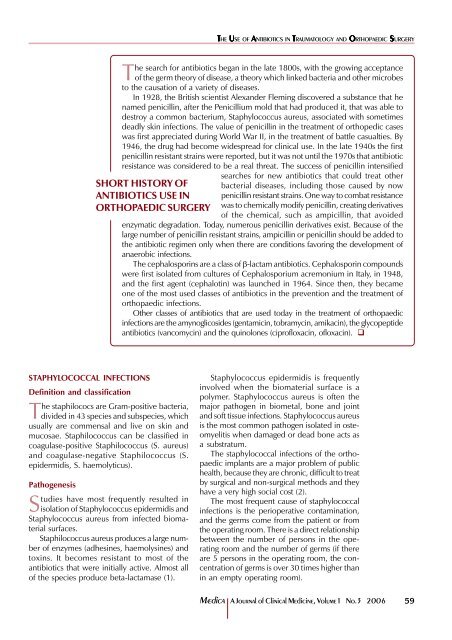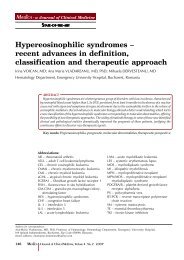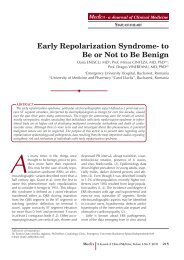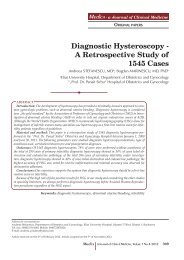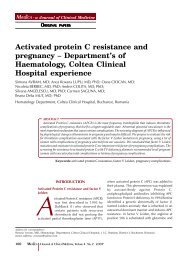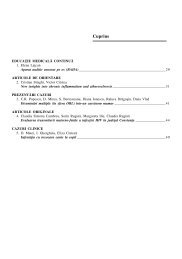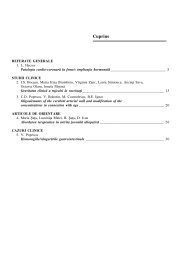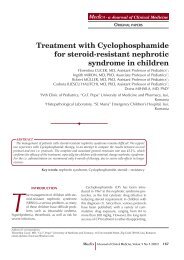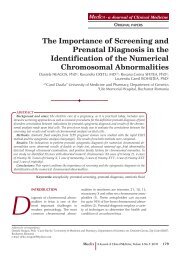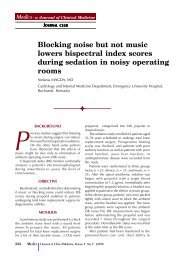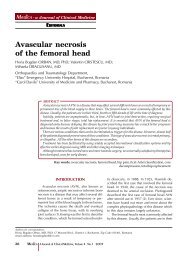The use of antibiotics in traumatology and orthopaedic surgery
The use of antibiotics in traumatology and orthopaedic surgery
The use of antibiotics in traumatology and orthopaedic surgery
Create successful ePaper yourself
Turn your PDF publications into a flip-book with our unique Google optimized e-Paper software.
STAPHYLOCOCCAL INFECTIONS<br />
Def<strong>in</strong>ition <strong>and</strong> classification<br />
<strong>The</strong> staphilococs are Gram-positive bacteria,<br />
divided <strong>in</strong> 43 species <strong>and</strong> subspecies, which<br />
usually are commensal <strong>and</strong> live on sk<strong>in</strong> <strong>and</strong><br />
mucosae. Staphilococcus can be classified <strong>in</strong><br />
coagulase-positive Staphilococcus (S. aureus)<br />
<strong>and</strong> coagulase-negative Staphilococcus (S.<br />
epidermidis, S. haemolyticus).<br />
Pathogenesis<br />
Studies have most frequently resulted <strong>in</strong><br />
isolation <strong>of</strong> Staphylococcus epidermidis <strong>and</strong><br />
Staphylococcus aureus from <strong>in</strong>fected biomaterial<br />
surfaces.<br />
Staphilococcus aureus produces a large number<br />
<strong>of</strong> enzymes (adhes<strong>in</strong>es, haemolys<strong>in</strong>es) <strong>and</strong><br />
tox<strong>in</strong>s. It becomes resistant to most <strong>of</strong> the<br />
<strong>antibiotics</strong> that were <strong>in</strong>itially active. Almost all<br />
<strong>of</strong> the species produce beta-lactamase (1).<br />
U<br />
A<br />
T<br />
THE UUSE<br />
U OF AANTIBIOTICS<br />
A<br />
IN TTRAUMATOLOGY<br />
T<br />
AND OORTHOPAEDIC<br />
O SSURGERY<br />
S<br />
<strong>The</strong> search for <strong>antibiotics</strong> began <strong>in</strong> the late 1800s, with the grow<strong>in</strong>g acceptance<br />
<strong>of</strong> the germ theory <strong>of</strong> disease, a theory which l<strong>in</strong>ked bacteria <strong>and</strong> other microbes<br />
to the causation <strong>of</strong> a variety <strong>of</strong> diseases.<br />
In 1928, the British scientist Alex<strong>and</strong>er Flem<strong>in</strong>g discovered a substance that he<br />
named penicill<strong>in</strong>, after the Penicillium mold that had produced it, that was able to<br />
destroy a common bacterium, Staphylococcus aureus, associated with sometimes<br />
deadly sk<strong>in</strong> <strong>in</strong>fections. <strong>The</strong> value <strong>of</strong> penicill<strong>in</strong> <strong>in</strong> the treatment <strong>of</strong> orthopedic cases<br />
was first appreciated dur<strong>in</strong>g World War II, <strong>in</strong> the treatment <strong>of</strong> battle casualties. By<br />
1946, the drug had become widespread for cl<strong>in</strong>ical <strong>use</strong>. In the late 1940s the first<br />
penicill<strong>in</strong> resistant stra<strong>in</strong>s were reported, but it was not until the 1970s that antibiotic<br />
resistance was considered to be a real threat. <strong>The</strong> success <strong>of</strong> penicill<strong>in</strong> <strong>in</strong>tensified<br />
searches for new <strong>antibiotics</strong> that could treat other<br />
bacterial diseases, <strong>in</strong>clud<strong>in</strong>g those ca<strong>use</strong>d by now<br />
penicill<strong>in</strong> resistant stra<strong>in</strong>s. One way to combat resistance<br />
was to chemically modify penicill<strong>in</strong>, creat<strong>in</strong>g derivatives<br />
<strong>of</strong> the chemical, such as ampicill<strong>in</strong>, that avoided<br />
enzymatic degradation. Today, numerous penicill<strong>in</strong> derivatives exist. Beca<strong>use</strong> <strong>of</strong> the<br />
large number <strong>of</strong> penicill<strong>in</strong> resistant stra<strong>in</strong>s, ampicill<strong>in</strong> or penicill<strong>in</strong> should be added to<br />
the antibiotic regimen only when there are conditions favor<strong>in</strong>g the development <strong>of</strong><br />
anaerobic <strong>in</strong>fections.<br />
<strong>The</strong> cephalospor<strong>in</strong>s are a class <strong>of</strong> β-lactam <strong>antibiotics</strong>. Cephalospor<strong>in</strong> compounds<br />
were first isolated from cultures <strong>of</strong> Cephalosporium acremonium <strong>in</strong> Italy, <strong>in</strong> 1948,<br />
<strong>and</strong> the first agent (cephalot<strong>in</strong>) was launched <strong>in</strong> 1964. S<strong>in</strong>ce then, they became<br />
one <strong>of</strong> the most <strong>use</strong>d classes <strong>of</strong> <strong>antibiotics</strong> <strong>in</strong> the prevention <strong>and</strong> the treatment <strong>of</strong><br />
<strong>orthopaedic</strong> <strong>in</strong>fections.<br />
Other classes <strong>of</strong> <strong>antibiotics</strong> that are <strong>use</strong>d today <strong>in</strong> the treatment <strong>of</strong> <strong>orthopaedic</strong><br />
<strong>in</strong>fections are the amynoglicosides (gentamic<strong>in</strong>, tobramyc<strong>in</strong>, amikac<strong>in</strong>), the glycopeptide<br />
<strong>antibiotics</strong> (vancomyc<strong>in</strong>) <strong>and</strong> the qu<strong>in</strong>olones (cipr<strong>of</strong>loxac<strong>in</strong>, <strong>of</strong>loxac<strong>in</strong>). �<br />
SHORT HISTORY OF<br />
ANTIBIOTICS USE IN<br />
ORTHOPAEDIC SURGERY<br />
Mædica A Journal <strong>of</strong> Cl<strong>in</strong>ical Medic<strong>in</strong>e, Volume1 No.3 2006 59<br />
O<br />
Staphylococcus epidermidis is frequently<br />
<strong>in</strong>volved when the biomaterial surface is a<br />
polymer. Staphylococcus aureus is <strong>of</strong>ten the<br />
major pathogen <strong>in</strong> biometal, bone <strong>and</strong> jo<strong>in</strong>t<br />
<strong>and</strong> s<strong>of</strong>t tissue <strong>in</strong>fections. Staphylococcus aureus<br />
is the most common pathogen isolated <strong>in</strong> osteomyelitis<br />
when damaged or dead bone acts as<br />
a substratum.<br />
<strong>The</strong> staphylococcal <strong>in</strong>fections <strong>of</strong> the <strong>orthopaedic</strong><br />
implants are a major problem <strong>of</strong> public<br />
health, beca<strong>use</strong> they are chronic, difficult to treat<br />
by surgical <strong>and</strong> non-surgical methods <strong>and</strong> they<br />
have a very high social cost (2).<br />
<strong>The</strong> most frequent ca<strong>use</strong> <strong>of</strong> staphylococcal<br />
<strong>in</strong>fections is the perioperative contam<strong>in</strong>ation,<br />
<strong>and</strong> the germs come from the patient or from<br />
the operat<strong>in</strong>g room. <strong>The</strong>re is a direct relationship<br />
between the number <strong>of</strong> persons <strong>in</strong> the operat<strong>in</strong>g<br />
room <strong>and</strong> the number <strong>of</strong> germs (if there<br />
are 5 persons <strong>in</strong> the operat<strong>in</strong>g room, the concentration<br />
<strong>of</strong> germs is over 30 times higher than<br />
<strong>in</strong> an empty operat<strong>in</strong>g room).<br />
S


